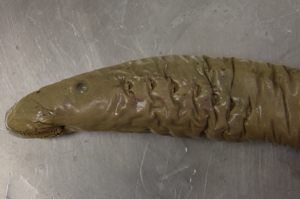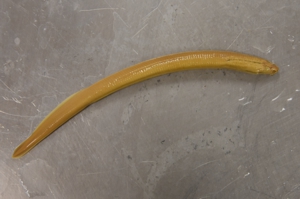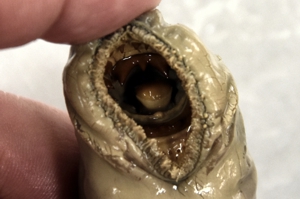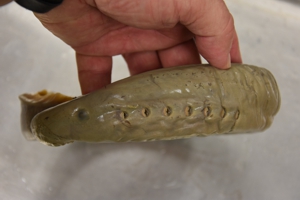Pacific Lamprey
Lampetra tridentata
Family: Petromyzontidae (Lampreys)
Etymology: lambere (to suck), petra (stone); referring to the breeding adults that cling to stones (Moyle 2002).
Distribution: From Hokkaido Japan north to the Aleutians, Alaska and south along the North American Pacific Coast, at least as far as San Diego, possibly into Baja California (Moyle 2002).
Similar species: River lamprey Lampetra ayresi
Imagine a fish that is hatched in freshwater, lives its early life in the rivers and streams of California, then makes a massive migration to the ocean where it lives for several years, then migrates back to freshwater to spawn. Most people think of Pacific salmon, such as the Chinook Salmon, as befitting such an adventurous lifestyle. While it is true of the Chinook, it is equally true of the Pacific lamprey. But lamprey are quite a bit "less attractive" in most people's eyes and so their story is often unappreciated.
Some people call them "eels", but they have nothing in common with anguillid fishes such as the American or European eel. In fact, the Eel River in northern California is so named due to the historical abundance of Pacific lamprey (Moyle 2002).
The true story of the lamprey is even more interesting than you might imagine.... A Pacific lamprey begins life as an egg laid amongst the cobbles and gravel of a river in California (or elsewhere along the Pacific coast of North America). There is some debate about the extent to which the parent lamprey might guard the eggs in the nest, but if they do guard, they are long gone before the eggs hatch. The egg hatches into a strange looking form called an "ammocoete larvae". The ammocoete lives partially buried in the bed of the stream or river and is a filter feeder. With its back end anchored into the sediment, and the head sticking out, facing into the current, water flows into the oral cavity, where small items of food are trapped and directed down to the stomach. The larvae lives this way for a long time, as long as 6 or 7 years (Moyle 2002).
Then, in a process not completely understood, the larvae begins to metamorphose into the adult form. The adult lamprey is completely different. First, it leaves the river bottom and migrates out to the ocean where it transforms into a parasitic adult, eventually reaching a size of up to 76 cm (Moyle 2002). It does not have a true jaw, hence sometimes lampreys and a few other jawless fishes are referred to as "Agnthans", meaning literally "without jaws". Instead, the adult lamprey has "cusps" in its mouth, hardened tooth-like blades. The adult lamprey attaches itself to the side of a prey (host) such as a salmon using the mouth region in a sort of suction-type action. Then it digs into the flesh of the prey using the cusps. It is unknown how often the host dies from this attack or whether this just inflicts a painful wound. Certainly a salmon with a large gapping wound has little appeal to fisherman or persons interested in eating salmon, which explains why lamprey have a poor reputation amongst such folks.
Also note that the lamprey does not have the typical gill slits seen in most fishes, but rather has gill pores (round holes) on the side of the head region.
After several years as a parasitic adult, the lampreys return to freshwater, where the adults construct a simple nest of stones amongst the gravel. These occur in the Lower American River and are sometimes mistaken for salmon nests (redds). They are typically found in the riffle areas of the river (Moyle 2002).
Landlocked species
There are other species of lamprey in California including some, such as the Pit-Klamath Brook Lamprey, that is land-locked, meaning that they do not migrate to the sea. These forms do not have a predatory adult form, but instead go rapidly from a ammocoete larvae to breeding adult. Despite such a fascinating life history, little is known about lampreys in general and much more needs to be known.
References and Resources
Moyle, P.B. (2002). Inland Fishes of California. Second Edition. University of California, Berkeley.
Photo credits: Ron Coleman



